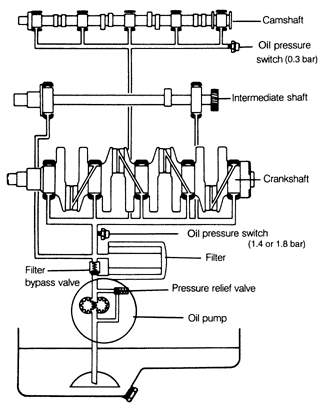7. Lubrication SystemThe primary function of the lubrication system is to lubricate the internal moving parts of the engine. The circulation of oil also aids engine cooling. Proper lubrication relies on a constant supply of oil, fed to the moving parts under pressure. Pressure is supplied by a gear-type oil pump located inside the oil pan. Engine oil returns to the oil pan where it is stored for pickup by the pump. It is cleaned by circulating through a replaceable filter. Fig. 7-1 is a schematic view of the lubrication system showing the paths of pressurized oil supply to the engine bearings. This section covers inspection, repair, and assembly of the parts of the lubrication system. Oil change, oil filter changes, and engine oil specifications are covered in greater detail in LUBRICATION AND MAINTENANCE.

To prevent serious engine damage, a dynamic oil pressure warning system warns the driver of insufficient oil pressure. Other safety features include a filter by-pass, to guard against bursting the filter due to over pressure, and an oil pump pressure relief valve to prevent excessive system pressure. On models equipped with multi-function indicators, an oil temperature sensor, located on the oil filter flange, monitors the oil temperature. On 16-valve engines, the sensor is located on the end of the cylinder head. Lubrication system problems result from the system's inability to create oil pressure, the engine's inability to maintain it, or faults with oil pressure warning systems. Because proper lubrication is directly related to engine life, its importance cannot be overemphasized. Change the engine oil and oil filter regularly, at least as often as specified by Volkswagen's recommended maintenance intervals, and periodically check engine oil level between oil changes. See LUBRICATION AND MAINTENANCE. |